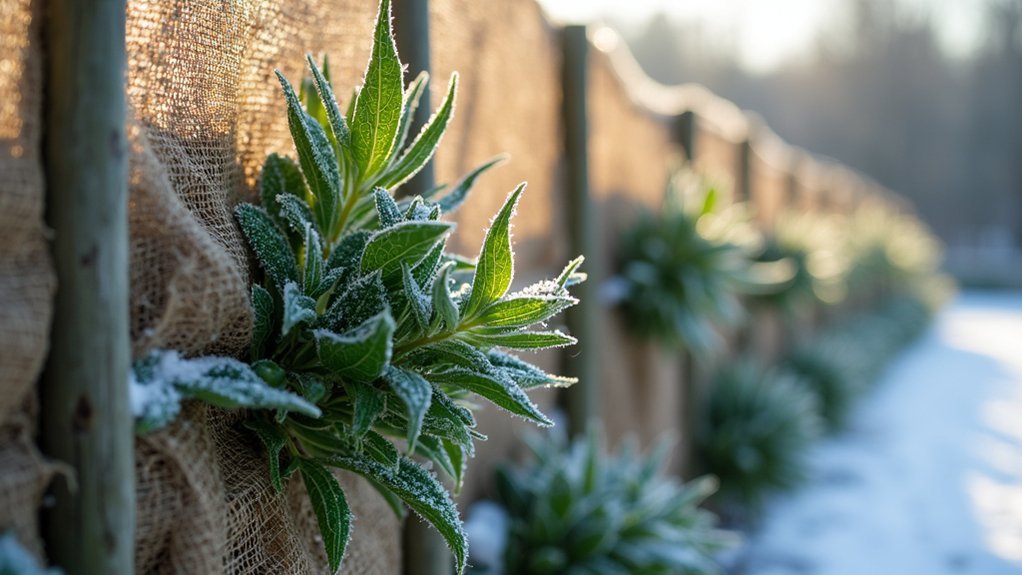To combat barrier plant diseases year-round, select disease-resistant varieties suited to your climate zone. Apply 2-3 inches of organic mulch, keeping it away from stems. Water deeply but infrequently in early mornings. Introduce beneficial insects for natural pest control. Use companion planting like marigolds to repel harmful insects. Prune infected areas promptly and maintain good air circulation. Apply protective coverings during extreme weather. These strategies will strengthen your living fence against even the toughest pathogens.
Strategic Year-Round Planning for Disease-Resistant Barriers

While many gardeners focus on seasonal planting strategies, developing an extensive year-round plan specifically for disease-resistant barriers requires thoughtful consideration of multiple factors.
Start by selecting inherently resistant varieties like Austin Pretty Limits® and Cinnamon Viburnum to reduce chemical treatments.
Disease resistance begins with variety selection—choose champions like Austin Pretty Limits® and Cinnamon Viburnum to naturally defend your garden space.
Create a layered design that incorporates native plants such as Bottlebrush Buckeye alongside hybrid varieties like ‘Cranberry Crush’ hibiscus. This diversity not only enhances visual interest but also provides resilience against pathogens. Consider using deer resistant evergreens like Sprinter Boxwood and Tortuga Juniper that won’t suffer from wildlife damage while maintaining your protective barrier.
Include evergreen shrubs for year-round stability and drought-tolerant options like Guava for durability during dry periods.
Remember to match plants to your climate zone and soil conditions. By thoughtfully combining different plant types, you’ll establish a robust barrier that stands strong against diseases while maintaining aesthetic appeal throughout all seasons.
Spring Preparation: Preventing Early-Season Barrier Plant Infections
You’ll create a healthier environment for your barrier plants by applying a 2-3 inch layer of mulch, which enhances beneficial soil microbes that naturally fight pathogens.
Keep the mulch slightly away from plant stems to prevent moisture-related diseases while still maintaining its protective benefits. Proper site preparation is critical for disease prevention and should be completed before planting your barrier species.
Consider planting companion species like marigolds or garlic near your barriers, as their natural compounds can repel insects that often spread early-season infections.
Mulch for Microbe Enhancement
As spring approaches, strategic application of organic mulch becomes a cornerstone of barrier plant disease prevention.
You’ll create a thriving microbial ecosystem by applying 2-3 inches of organic mulch around your barrier plants before the growing season begins.
This protective layer does more than suppress weeds—it fosters beneficial bacteria and fungi that improve nutrient cycling and plant resilience.
As organic mulch decomposes, it provides food for microorganisms that help your plants fight off pathogens naturally.
The mulch layer also stabilizes soil temperature and moisture, creating ideal conditions for beneficial microbes to flourish.
This microclimate protection reduces plant stress during temperature fluctuations common in early spring.
Organic mulch enhances your soil’s cation exchange capacity, significantly improving how nutrients are retained and made available to your barrier plants.
For best results, keep mulch slightly away from plant stems to prevent rot while maximizing its disease-suppressing benefits.
Strategic Pest-Repelling Plantings
Spring preparation for healthy barrier plants should include thoughtful integration of pest-repelling species.
Plant marigolds, nasturtiums, and sweet alyssum around your garden’s perimeter to create protective barriers against common pests. Nasturtiums serve as effective trap crops, drawing aphids away from your valuable barrier plants.
Position aromatic herbs like basil and rue near entry points to deter insects before they reach your garden. This approach creates a chemical-free solution that reduces the need for harmful pesticides in your garden ecosystem.
Don’t forget to implement polycultures—mix alliums throughout your planting beds to protect neighboring plants from pest invasions.
For extensive protection, combine these botanical strategies with physical barriers and beneficial insects.
Ladybugs and lacewings will help control pest populations naturally. Regular inspection and pruning of your plants prevents pest habitats from developing, while maintaining diverse plantings ensures year-round resilience against potential disease vectors.
Summer Maintenance Techniques for Healthy Living Fences

Maintaining healthy living fences during summer’s intense heat requires strategic care to prevent stress and disease. Water deeply but infrequently in early mornings to develop resilient root systems that reach 12-18 inches deep. Apply 2-3 inches of organic mulch while keeping it away from stems. Introducing beneficial insects can naturally help control harmful pest populations on your barrier plants.
| Technique | Benefit | Implementation |
|---|---|---|
| Drip irrigation | Targets roots, reduces waste | Install at plant base |
| Strategic shading | Prevents sunscald | Use 30-50% shade cloth |
| Morning watering | Reduces fungal issues | Complete before 9 AM |
| Minimal pruning | Preserves natural protection | Remove only damaged parts |
Monitor for wilting and pest issues regularly. When necessary, blast pests with water or apply insecticidal soaps rather than harsh chemicals that might stress plants further.
Fall Interventions to Strengthen Barrier Plants Before Winter
Fall preparation serves as the critical foundation for barrier plant survival during harsh winter months.
Begin by applying mulch after the first killing frost to insulate roots and prevent soil temperature fluctuations. You’ll need to maintain adequate fall watering to strengthen plants before winter’s arrival.
Proper mulching after frost and consistent autumn hydration fortify barrier plants against winter’s harsh challenges.
Protect your barrier plants from animal damage by installing fencing or small barriers. Wrap vulnerable specimens with burlap to shield against desiccating winds and prevent sunscald.
If you’re using sawdust mulch, consider adding urea to prevent nutrient deficiencies.
Apply fungicides proactively to prevent winter fungal infections, and guarantee proper drainage to discourage disease development.
For thin-barked species, especially newly planted trees, use white tree wraps to prevent sunscald damage during temperature fluctuations. Avoid late-season pruning which can stimulate new foliage growth that won’t have time to harden off before winter arrives.
Winter Protection Strategies for Vulnerable Natural Fencing

Winter protection for vulnerable natural fencing requires strategic intervention to guarantee survival through harsh conditions. Shield your plants from salt spray and wind damage by installing burlap barriers or creating teepee structures with wooden stakes.
Apply a thick layer of organic mulch around plant bases to insulate roots while maintaining moisture. For extreme weather, cover plants with frost cloth or burlap, ensuring you’ve secured these materials with stakes or rocks to prevent displacement.
Remember to allow for air circulation to avoid overheating and condensation issues. Monitor weather forecasts vigilantly and provide nighttime protection during frost events.
Check your protective structures daily, removing ice formations and debris that could compromise their effectiveness. Before winter arrives, thoroughly prune dead branches to minimize potential breakage from heavy snow accumulation. By maintaining proper mulching and reducing de-icing salt use, you’ll help your natural fencing survive winter’s challenges.
Companion Planting Systems to Enhance Barrier Health
Companion planting systems serve as a powerful defense mechanism for barrier plants by mimicking nature’s diverse ecosystems. When you implement strategic combinations, you’ll notice improved disease resistance and reduced pest issues without chemical interventions. Different root systems work together to improve the overall soil structure and health of your barrier plantings.
| Companion Plant | Benefits | Best Barrier Pairing |
|---|---|---|
| Marigolds | Repel nematodes, deter fungi | Hedgerows, living fences |
| Nasturtiums | Repel aphids, whiteflies | Vegetable barriers, windbreaks |
| Chives | Enhance flavor, increase pest resistance | Fruiting barrier plants |
Use spinal or layered planting techniques to maximize space while creating protective microclimates. Remember to match companions with similar sun, moisture, and soil requirements as your barrier plants. Regularly inspect your plantings and maintain proper pruning schedules to prevent overcrowding and promote air circulation throughout your living barriers.
Organic Solutions for Common Seasonal Barrier Plant Diseases

While companion planting creates natural defenses, organic management offers targeted solutions when seasonal diseases emerge in your barrier plants.
Thoughtful plant pairing strengthens gardens, but organic interventions remain essential when nature needs a helping hand.
When you notice signs of fungal issues, try natural remedies before reaching for harsh chemicals.
- Apply milk sprays (1:2 milk-to-water ratio) to effectively control powdery mildew on your barrier plants during humid periods.
- Use neem oil as a dual-purpose treatment that tackles both fungal problems and pest infestations simultaneously.
- Create baking soda sprays to manage mildew issues, especially effective when applied preventatively.
- Incorporate regular soil amendments with compost to build disease resistance from the ground up.
Remember to prune infected areas promptly and improve air circulation around your plants to minimize fungal spread naturally. Stagnant air creates ideal conditions for fungal diseases to develop and spread among your barrier plantings.
Regular inspections will help you catch problems early.
Frequently Asked Questions
Can Barrier Plants Increase Certain Pest Populations if Chosen Incorrectly?
Yes, you’ll find barrier plants can increase pest populations when chosen incorrectly. They might provide food and shelter, become host plants, or disrupt natural enemy dynamics, potentially creating a more favorable environment for pests.
How Do Barrier Plants Affect Pollinators During Different Seasons?
Your barrier plants provide seasonal resources for pollinators – offering nectar in spring, shelter in summer, food in fall, and protection in winter. They’ll support different pollinator life stages year-round when properly selected.
Do Barrier Plants Require Different Nutrient Profiles Than Protected Crops?
Yes, barrier plants do require different nutrient profiles than protected crops. You’ll need to provide them with higher nitrogen for foliage growth and additional micronutrients to help them withstand environmental stress and exposure.
Can Barrier Plants Transfer Beneficial Microbes to Adjacent Crops?
Yes, barrier plants can transfer beneficial microbes to your adjacent crops through root exudates, mycorrhizal networks, and shared rhizosphere zones, enhancing pathogen resistance, nutrient uptake, and overall plant health in your garden.
How Does Climate Change Impact Barrier Plant Effectiveness?
Climate change weakens your barrier plants through increased stress, altered growing seasons, and new pathogens. You’ll notice reduced effectiveness as they struggle with extreme weather and disrupted ecological relationships they’ve evolved to maintain.
In Summary
You’ve got the tools to defend your barrier plants throughout all seasons. By implementing these preventative strategies, you’ll create resilient living fences that withstand disease pressure year-round. Don’t wait for problems to appear—act now with consistent care, companion planting, and organic treatments. Your diligence will reward you with strong, healthy barriers that protect and beautify your property for years to come.





Leave a Reply